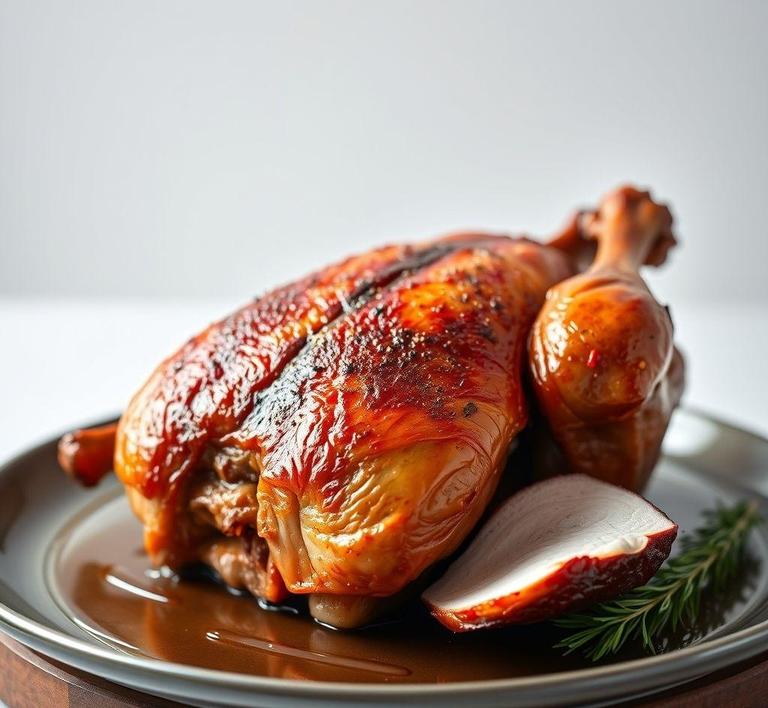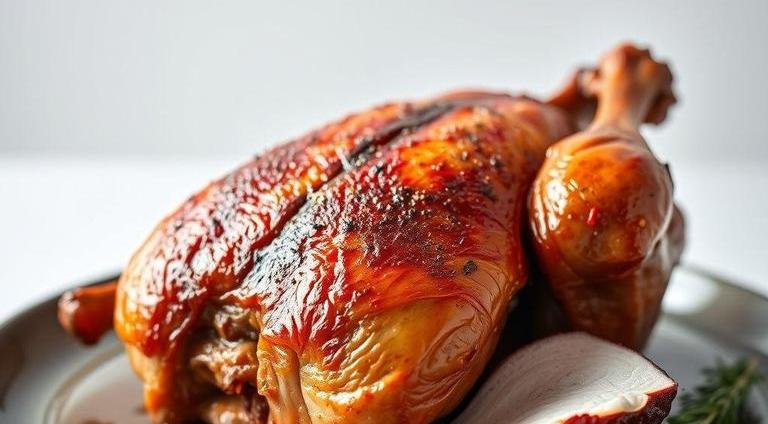Gordon Ramsay’s Roasted Duck Recipe [+Tips & Tricks]
Because when a Michelin-starred chef like Gordon Ramsay roasts duck, you’re not just getting dinner-you’re experiencing a masterclass in crispy skin, succulent meat, and flavor layering that will elevate your culinary repertoire.
What Is Gordon Ramsay’s Roasted Duck
Gordon Ramsay’s roasted duck is a culinary symphony that marries the rich, gamey depth of duck meat with crisped-to-perfection skin and layers of aromatic flavors. Drawing inspiration from classic French and Asian influences, this dish balances technique and simplicity.
Ramsay often pairs his duck with elements like star anise, Chinese five spice, honey, or a tangy cherry or orange glaze-depending on the version-to strike that perfect balance of savory, sweet, and acidic notes. It’s elegance on a plate, offering a crisp, golden skin enveloping juicy, rosy-pink meat that melts in your mouth.
Gordon Ramsay’s Roasted Duck Recipe
Ingredients Needed

Here’s a refined list of what you’ll typically need to prepare Gordon Ramsay’s roasted duck. While the recipe may vary slightly depending on the flavor profile (French-style or Asian-fusion), here’s a versatile set of ingredients:
Main Ingredients:
- 1 whole duck (around 2-2.5 kg)
- Salt and freshly ground black pepper
- 2-3 star anise pods
- 1 orange (zested and quartered)
- 4 garlic cloves (crushed)
- 1 small bunch of thyme
- 2 tablespoons soy sauce
- 2 tablespoons honey
- 1 tablespoon Chinese five-spice powder
- 1 small cinnamon stick (optional)
Optional for glaze or sauce:
- Balsamic vinegar or red wine
- Fresh cherries or orange marmalade
- Duck stock or chicken stock
Equipment Needed
To bring this dish to life, you’ll need a few key kitchen tools:
- Roasting tray with rack (vital for rendering fat and crisping the skin evenly)
- Sharp chef’s knife or poultry shears
- Kitchen string (for trussing the bird)
- Basting brush (for applying glaze)
- Meat thermometer (essential for precise doneness)
- Saucepan (for reduction or glaze)
- Tongs and carving knife
How To Make Gordon Ramsay’s Roasted Duck?
Step-by-step, here’s how to create this showstopper of a dish:
-
Prep the Duck:
- Remove any giblets from the cavity and pat the duck dry with paper towels.
- Score the skin in a crisscross pattern with a sharp knife-careful not to cut into the meat. This helps render the fat and crisps the skin.
- Season generously with salt, pepper, and Chinese five-spice (if using).
-
Stuff and Flavor:
- Fill the cavity with orange quarters, garlic cloves, thyme, and star anise.
- Optionally add a splash of soy sauce and a cinnamon stick for extra depth.
-
Roast Low and Slow:
- Preheat your oven to 170°C (340°F).
- Place duck on a rack in the roasting tray breast-side up. Roast for about 1 hour 45 minutes to 2 hours, depending on weight.
- Halfway through, carefully remove excess rendered fat (save it-liquid gold for roast potatoes!).
-
Glaze and Crisp:
- With about 15-20 minutes left, mix honey with soy sauce or orange marmalade, and brush it over the duck.
- Increase oven temp to 200°C (390°F) to caramelize and crisp the skin.
-
Rest and Carve:
- Rest the duck for 15-20 minutes under foil before carving. This helps retain juices.
- Serve with a simple reduction of duck juices and wine or fruit glaze.
Expert Tips
- Dry skin = crispy skin. Leave the duck uncovered in the fridge overnight for best results.
- Use the rendered duck fat for the most incredible roast potatoes or sautéed vegetables.
- Don’t overcook! Duck breast is best served medium-rare to medium for maximum tenderness.
- Pair it smart: Serve with acidic sides like red cabbage, citrus salad, or a cherry sauce to cut through the richness.
- Save the bones for stock-duck broth makes an excellent base for risotto or ramen.
Gordon Ramsay’s roasted duck isn’t just a recipe-it’s a culinary experience that challenges you to elevate your cooking while rewarding you with deeply satisfying flavors. With its golden skin, juicy meat, and dynamic aromatics, this dish is guaranteed to impress dinner guests or turn a weekend meal into a celebration. Whether you’re a seasoned home cook or venturing into duck for the first time, following Ramsay’s method offers a rewarding, flavorful journey into the heart of fine dining made accessible at home.
Easy Recipe Variations For Gordon Ramsay’s Roasted Duck

Gordon Ramsay’s roasted duck is already a showstopper, but even the best recipes invite reinterpretation. The classic Ramsay duck typically involves crisped skin, rendered fat, and a fragrant balance of sweet and savory-often accompanied by ingredients like star anise, orange, and Chinese five-spice. But here’s how you can shake things up while preserving its culinary elegance:
-
Citrus Glazed Duck with a French Twist
Instead of Ramsay’s Asian-inspired spice profile, go Provençal. Swap five-spice for Herbes de Provence, and trade the orange glaze for a citrus reduction made with blood orange juice, honey, and a splash of Grand Marnier. Garnish with roasted figs and thyme sprigs for a luxurious French countryside vibe. -
Pomegranate Molasses & Za’atar Roasted Duck
For a Middle Eastern flavor burst, marinate the duck in a blend of pomegranate molasses, garlic, lemon juice, and za’atar. This imparts a rich tanginess that contrasts beautifully with the fattiness of the duck. Serve with couscous, toasted pine nuts, and fresh mint for a vibrant, exotic dinner. -
Smoked Tea Duck
Inspired by Chinese camphor-smoked duck, you can infuse Ramsay’s duck with lapsang souchong tea. Steep tea leaves with soy, ginger, and brown sugar, and use the liquid to marinate the bird. Roast as usual, and finish with a honey-soy glaze for a nuanced, smoky sweetness. -
Maple-Bourbon Glazed Duck
Perfect for fall, this version leans into comforting, earthy notes. Create a glaze with pure maple syrup, bourbon, Dijon mustard, and a hint of clove. Add roasted root vegetables-parsnips, carrots, and turnips-and you’ve got an autumn feast that will warm the soul. -
Thai-Inspired Red Curry Duck
Want heat and coconut richness?Coat the duck in a red curry paste mixed with coconut milk, lime zest, and fish sauce. Roast, then reduce the leftover marinade into a creamy, spicy sauce. Serve with jasmine rice and grilled baby bok choy.
Best Practices To Store Leftovers
Duck leftovers are too precious to waste. That luscious meat and decadent fat can be repurposed masterfully, but only if stored properly:
- Cool Down Safely: Let the duck rest to room temperature, but don’t leave it out for more than 2 hours to avoid bacterial growth.
- Divide & Conquer:
- Carve the meat from the bones and store it in an airtight container.
- Keep the bones for stock (duck bone broth is golden!).
- Strain and save the rendered duck fat-it’s liquid gold for frying potatoes or eggs.
- Refrigeration:
- Duck meat lasts up to 3-4 days in the fridge.
- Duck fat, when strained properly, can last for months refrigerated or indefinitely when frozen.
- Freezing Tips:
- Freeze sliced duck meat wrapped in parchment paper, then seal in a freezer bag or vacuum pouch. It keeps for up to 2-3 months.
- Duck confit (salt-cured, slow-cooked in its own fat) freezes beautifully and is a clever way to preserve leftovers while elevating them.
What Goes Well With Roasted Duck?
Duck is rich and full-bodied, which means it craves companions that cut through fat or complement its robust flavor. Here are some show-stealing sidekicks:
- Fruits with Acidity
- Orange segments or cranberry compote bring brightness and zing.
- Sautéed cherries or grilled peaches add sweetness and depth.
- Root Vegetables & Purées
- Parsnip or celeriac purée is silky and earthy-great duck canvases.
- Roasted carrots with a drizzle of honey and cumin are both sweet and spicy.
- Greens with Bite
- Sautéed kale or Swiss chard with garlic balances duck’s richness.
- Bitter greens like radicchio or endive, especially when charred or grilled, offer contrast.
- Grains & Starches
- Wild rice pilaf or a barley risotto bring texture and a nutty counterpoint.
- A creamy polenta with a touch of blue cheese creates a decadent pairing.
- Bold Wines
- Pinot Noir is the classic duck wine-its acidity and berry notes match perfectly.
- For something daring, try a Syrah or GSM blend for peppery complexity.
Conclusion
Gordon Ramsay’s roasted duck is a culinary centerpiece that’s as versatile as it is impressive. By exploring easy flavor variations-from French citrus glazes to Thai curry twists-you can personalize the dish to your taste or the season.
With smart storage habits, your efforts stretch even further, turning leftovers into gourmet delights. And when paired with the right sides and wines, roasted duck doesn’t just make a meal-it makes a memory.
FAQs
What Ingredients Are Needed For Gordon Ramsay’s Roasted Duck Recipe?
Gordon Ramsay’s roasted duck recipe typically requires a whole duck, olive oil, salt, pepper, garlic, thyme, rosemary, and orange zest. Optional ingredients include honey or balsamic vinegar for glazing.
How Do I Prepare The Duck Before Roasting It?
Before roasting, you should pat the duck dry to ensure a crispy skin. Score the skin lightly in a criss-cross pattern to help the fat render out during cooking. Season the duck with salt, pepper, and herbs like thyme and rosemary.
What Temperature Should I Roast The Duck At?
The duck should be roasted at 180°C (350°F) for about 1 to 1.5 hours. However, you should start roasting at a higher temperature of 220°C (425°F) for the first 15 minutes to help the skin crisp up.
How Do I Ensure The Duck Is Cooked Through Without Being Dry?
To avoid dry meat, roast the duck at a moderate temperature and use a meat thermometer to ensure it reaches 75°C (165°F) in the thickest part of the meat. Additionally, basting the duck during roasting can help keep the meat moist.
Can I Use A Different Herb Or Seasoning In Gordon Ramsay’s Roasted Duck Recipe?
Yes, you can experiment with different herbs like sage or marjoram, or use other seasonings like ground cinnamon, five-spice powder, or even a dash of chili flakes to give the duck a unique flavor profile.
Do I Need To Truss The Duck Before Roasting?
Trussing the duck is optional. Some people prefer to truss it to ensure even cooking and to keep the legs in place. However, it’s not strictly necessary in Gordon Ramsay’s method, as the skin can be cooked crispy without this step.
How Do I Make The Sauce For Gordon Ramsay’s Roasted Duck?
Gordon Ramsay often makes a simple sauce by deglazing the roasting pan with orange juice, wine, or stock, and then reducing it to concentrate the flavors. You can add a touch of honey or balsamic vinegar for sweetness and acidity.
Should I Cover The Duck While Roasting It?
No, you should not cover the duck during roasting. The skin needs to remain exposed to the heat to become crispy. However, if the skin is getting too dark before the duck is fully cooked, you can loosely cover it with foil to prevent burning.
How Can I Serve Gordon Ramsay’s Roasted Duck?
Gordon Ramsay’s roasted duck can be served with a variety of side dishes like mashed potatoes, roasted vegetables, or a salad. You can also pair it with a sweet sauce, such as an orange or berry sauce, to complement the rich flavor of the duck.
What Should I Do With The Leftover Duck?
Leftover roasted duck can be shredded and used in salads, sandwiches, or wraps. You can also incorporate it into soups, stews, or make a duck confit for a different dish.
